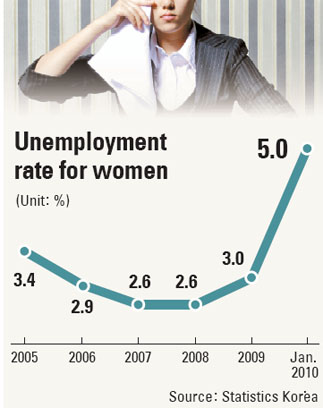Downturn hits working women harder than men

According to recent data from the state-run agency Statistics Korea, the number of unemployed women seeking work rose 76.2 percent in January from a year earlier. During the same period, the number of unemployed men rose 27.2 percent.
There were 495,000 unemployed women in Korea in January, the highest since July 1999, when the figure hit 502,000, the agency said.
Experts attribute the disproportional job loss to the fact that many women work in retail, manufacturing and service industries which are more sensitive to an economic slump, and more prone to cut jobs as a way of reducing costs.
Last year, a total of 126,000 jobs disappeared from the manufacturing industry, and of them, 110,000 were occupied by women, the Statistics Korea data showed. The food and hospitality industries also lost 107,000 jobs, 103,000 of them once held by women.
At the root of the inequality is a series of structural problems.
Because of the role traditionally required of women as primary caregivers of children, they tend to be more likely to take part-time or irregular jobs than men. But the low job security associated with these jobs has led women to suffer more than men during the economic crisis.
The Ministry of Strategy and Finance has said the government is aware of the problem and that women and young people have been hit hardest.
According to an OECD report released last September, Korea was third from the bottom among the 30 developed countries for participation by women in the labor force in 2008. The participation rate among Korean women aged 15 to 64 was 54.7 percent, ahead of only Turkey and Mexico, which had 26.7 percent and 43.4 percent participation, respectively. The OECD average was 61.3 percent.
The Finance Ministry hopes to raise the labor force participation rate of Korean women to 60 percent by 2014 by promoting flexible hours, support for child-rearing and job training after maternity leave, among other measures.
But Lee Jeong-il, an economist at the Samsung Economic Research Institute, said results won’t come quickly.
“Improving employment conditions for women is possible [only] with a full-fledged economic recovery as well as a change in industrial structure and enhanced labor flexibility,” Lee said.
By Moon Gwang-lip [joe@joongang.co.kr]










with the Korea JoongAng Daily
To write comments, please log in to one of the accounts.
Standards Board Policy (0/250자)